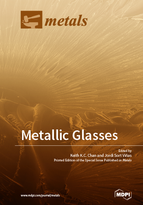Metallic Glasses
A special issue of Metals (ISSN 2075-4701).
Deadline for manuscript submissions: closed (30 April 2015) | Viewed by 79474
Special Issue Editors
Interests: advanced manufacturing technology, and materials engineering and processing
Interests: nanocrystalline alloys, metallic glasses, metallic films and patterned structures, nanomechanical properties, magnetic behaviour, phase transformations, modeling
Special Issues, Collections and Topics in MDPI journals
Special Issue Information
Dear Colleagues,
Metallic glasses, a family of metallic materials with metastable glassy states, are obtained by rapid cooling of liquid alloys. Because of their amorphous atomic structures, metallic glasses exhibit unique mechanical, physical, and chemical properties, which are superior to conventional metals’ and alloys’, within a wide range of potential applications.
With the combination of high strength, elasticity, and fracture resistance, bulk metallic glasses (BMGs) have attracted tremendous research interest over the past few decades. However, low tensile ductility is still one of the key issues of BMGs in structural applications. Due to its high accuracy in replicating complicated mold shapes, the die casting technique has been successfully applied to produce BMG products. On the other hand, metallic glasses can also be formed into complex shapes, like plastics, in the supercooled liquid region, due to their high thermal-plastic forming abilities.
In addition to their unique mechanical properties, metallic glasses have also demonstrated interesting physical and chemical properties. For example, some metallic glasses have been found to have good magnetocaloric effects and display catalytic behavior, with potential for magnetic refrigeration or catalytic applications. In recent years, metallic glass thin films and coatings have also drawn much attention due to their potential engineering and biomedical applications.
Up to now, despite the encouraging achievements, the wide application of metallic glasses is still somewhat hindered by the mysterious physical origins of the unique properties, and by the difficulties in exploiting the alloys with benchmark performances. The wide range of studies will continue to further uncover the underlying physical meanings, and to expand the application potential of metallic glasses. Papers on recent advances, and review articles, particularly in regard to fundamental properties and the structural and functional applications of metallic glasses, are invited for inclusion in this Special Issue on "Metallic Glasses".
Prof. K.C. Chan
Prof. Dr Jordi Sort Viñas
Guest Editors
Manuscript Submission Information
Manuscripts should be submitted online at www.mdpi.com by registering and logging in to this website. Once you are registered, click here to go to the submission form. Manuscripts can be submitted until the deadline. All submissions that pass pre-check are peer-reviewed. Accepted papers will be published continuously in the journal (as soon as accepted) and will be listed together on the special issue website. Research articles, review articles as well as short communications are invited. For planned papers, a title and short abstract (about 100 words) can be sent to the Editorial Office for announcement on this website.
Submitted manuscripts should not have been published previously, nor be under consideration for publication elsewhere (except conference proceedings papers). All manuscripts are thoroughly refereed through a single-blind peer-review process. A guide for authors and other relevant information for submission of manuscripts is available on the Instructions for Authors page. Metals is an international peer-reviewed open access monthly journal published by MDPI.
Please visit the Instructions for Authors page before submitting a manuscript. The Article Processing Charge (APC) for publication in this open access journal is 2600 CHF (Swiss Francs). Submitted papers should be well formatted and use good English. Authors may use MDPI's English editing service prior to publication or during author revisions.
Keywords
- bulk metallic glasses
- metallic glass thin films or coatings
- mechanical and physical properties
- thermal-plastic forming ability
- structural and functional applications







